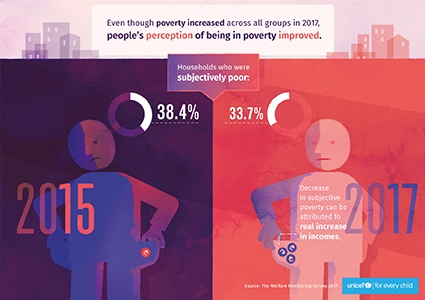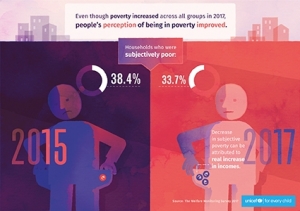2017 UNICEF Welfare Monitoring Survey Highlights Continued Poverty
This week, UNICEF Georgia released the 2017 results of its annual Welfare Monitoring Survey (WMS).
The report’s major findings are that the Georgian government’s social protection programs have improved at being able to identify poor families with children and that average household income has significant increased compared with 2015. Poverty remains a major challenge, however, and disproportionately affects children, who are more likely to be poor than the general population or pensioners.
UNICEF estimates that 4.3% of all households, or 5.0% of the population, 6.8% of children and 3.7% of pensioners, live below the extreme poverty line ($1.25 per day). Higher levels of education and, unsurprisingly, a household member having regular paid work reduces the incidence of child poverty.
The WMS reports that the average household income in Georgia was GEL 771.9 ($314) a month in 2017, and 608.9 ($248) in 2015. While non-monetary indicators of child poverty have improved, consumption poverty is increasing. As survey findings show, children have more durable goods in their households and there are less children living in poor housing conditions than in 2015, but monetary poverty indicators are on the rise. Still, almost 9.3% of urban children and 32.9% of rural children live in households with unimproved sanitation facilities.
The report attributes increased poverty rates primarily to a lack of strong and inclusive economic growth, unemployment, and higher consumer prices. General poverty rates increased from 16.4% of total households in 2015 to 19.6% in 2017, which is much better than in 2013, where estimates put general poverty at nearly 22% of households.
Real salaries (adjusted for 2010 prices) increased from 2015 by 2.2% to an average of GEL 940 ($382) a month in 2016. There is a large gender wage gap – men’s average nominal salary was GEL 1116.6 ($455) in 2016 while women earned an average of just GEL 731.2 ($298). However, the change from 2015 was an increase of 4% for men and 5.6% for women.
Social protection expenditure is the largest spending item in the state budget, accounting for 24.6% of the central public expenditure, (6.7% of GDP) in 2017, most of which goes towards pensions. Targeted Social Assistance (TSA), which aims to improve the socio-economic conditions of families experiencing financial and material hardship, had a monthly budget of GEL 21,128,468 ($8,606,301.13)in 2017, and allocated its budget to needy Georgians. The TSA benefit ranges from GEL 30 to GEL 60, plus a GEL 10 ($4) child benefit for each child under 16 years-old. As of September 2017, 324,177 households were registered in the unified database for socially vulnerable families, yet only 12.4% had received cash benefits due to limited funds. UNICEF estimates that without the TSA benefit, extreme poverty among children would be at 13.1% rather than today’s 6.8%.
Poverty starkly effects education. Children from poor households tend not to attend preschool or primary school. 98% of children in the country’s richest quintile attended school between the ages of 15-18, while less than 81% of children in the poorest quintile attended school. Only about 5% of 20-year-olds from the poorest quintile attended some type of educational institution after high school, versus 77% from the richest.
A positive finding from the report noted that all aspects of social exclusion except ‘accessing land ownership or employment’ showed an impressive decline. There is also a tendency that local households are less dependent on transfers from abroad and get more income from their own labor, which indicates some improvement in the country’s economic situation.
“Children still remain the most vulnerable group in Georgia’s society,” said Laila Omar Gad, UNICEF Representative in Georgia. “To reduce child poverty, a comprehensive social protection system is needed and child benefits should be expanded in amount and in coverage. At the same time, family support services and child care needs to be expanded in Georgia to support families with children,” she added.
Other key findings include:
• Categorical benefits (for persons with disabilities, IDPs, etc.) significantly reduce the incidence of poverty.
• People’s perception of being in poverty has improved, most likely due to real increases in incomes.
• The average out of pocket expenditure on health increased, and purchasing medicines remains the main component of healthcare spending.
• To cope with economic hardships, more families resort to borrowing. Use of financial instruments (banks and pawn shops) considerably increased in poor families.
• 6 out of 10 children aged 3-5 from poor families have no or insufficient access to children’s books.
Access the full study on the UNICEF Georgia website. The Welfare Monitoring Study is a biennial household survey covering all government-controlled regions of Georgia. In 2017, surveys were administered in July and August, and examining the prevalence and distribution of consumption poverty, material deprivation, subjective poverty and social exclusion. UNICEF says the results are nationally representative, with 4,697 households having completed the questionnaire. The aim of the WMS is 1) to review recent socio-economic trends in Georgia, 2) to assess the dynamics of key welfare indicators and compare the findings with the results of earlier rounds of the WMS; and 3) to capture the effects of Georgia’s TSA reform and provide policy-makers detailed information on developments that have taken place since the introduction of the new methodology and benefit scheme in 2015.
By Samantha Guthrie












